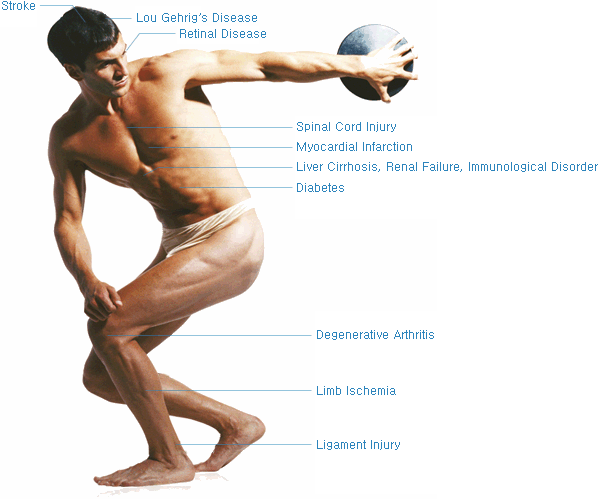GO
GO MAIN MENU
GO LEFT MENU
GO BODY
Stem cell is a undifferentiated cell self renewing. It is multi-potent cell that can differentiate into over 210 different types of tissue cells consisting our body.
- Self-Renewa : Stem cell can grow in number with maintaining the same shape and function.
- Differentiation : Stem cell remains undifferentiated until the body needs it to turn into special types of tissue through structural and functional change.
- Homing Effect : : Inside body, there is a special stem cell trafficking system that delivers stem cells where they are needed.
Stem cells are more localized in damaged area when they are injected intravenously.
Embryonic and adult stem cell
Adult stem cells are free of ethical or safety issues because they are extracted from fat, placenta, bone marrow or umbilical cord
blood while embryonic stem cells are unsafe and unethical because they have tumorigenicity and are extracted by the destruction
of embryos. Especially fat or placenta derived stem cells are safe and pluripotent so that can be applied to treat various cellular
damage diseases that have no known cure by current medical practice such as diabetic mellitus, Alzheimer, osteoarthritis.
Myocardial infarction, cerebral neuropathy or renal failure.
| Embryonic Stem Cell | Autologous Adult Stem Cell | |
|---|---|---|
| Feature | Toti-potent stem cell isolated from blastocysts grown from fertilized eggs | Pluripotent stem cells residing in various tissues and organs |
| Pro |
Theoretically can differentiate any type of cell
Abundant research results Fast growing |
Rapidly growing hot topic No immunogenic activity, No ethical issue Clinically commercialized due to the high safety profile Pluripotent enough for therapeutic effects |
| Con |
Ethical issue for embryo destruction and fertilized egg utilization Immunogenic Very difficult to clinically develop because of its tumorigenicity |
Lower differentiation ability than that embryonic |
| Type | Characteristics |
|---|---|
| Umbilical Cord Blood | Hematopoietic stem cell for displacement of bone marrow transplant. Available only on delivering |
| Placenta | Easy isolation, Available only on delivering |
| Fat | Easy isolation, Highest stem cell contents, No age limitation for isolation, No immune rejection, High differentiation potential, Easy expansion |
| Bone Marrow |
Difficult to isolate. Low stem cell content. Difficult to grow Long research history |
- Wound healing : Regeneration of damaged cells
- Differentiation : Stem cell turns into a special type cell to replace damaged cell with newly differentiated cell
- Cytokine secretion : : Improving surrounding tissue by secreting various effective growth factors and hormones
- Immune modulation : Interacting with immune system to bring it normal activity
- Anti-apoptosis : Preventing programmed cell death
- Neovasculizaiton : :Increasing blood circulation through regenerating new blood vessels






































